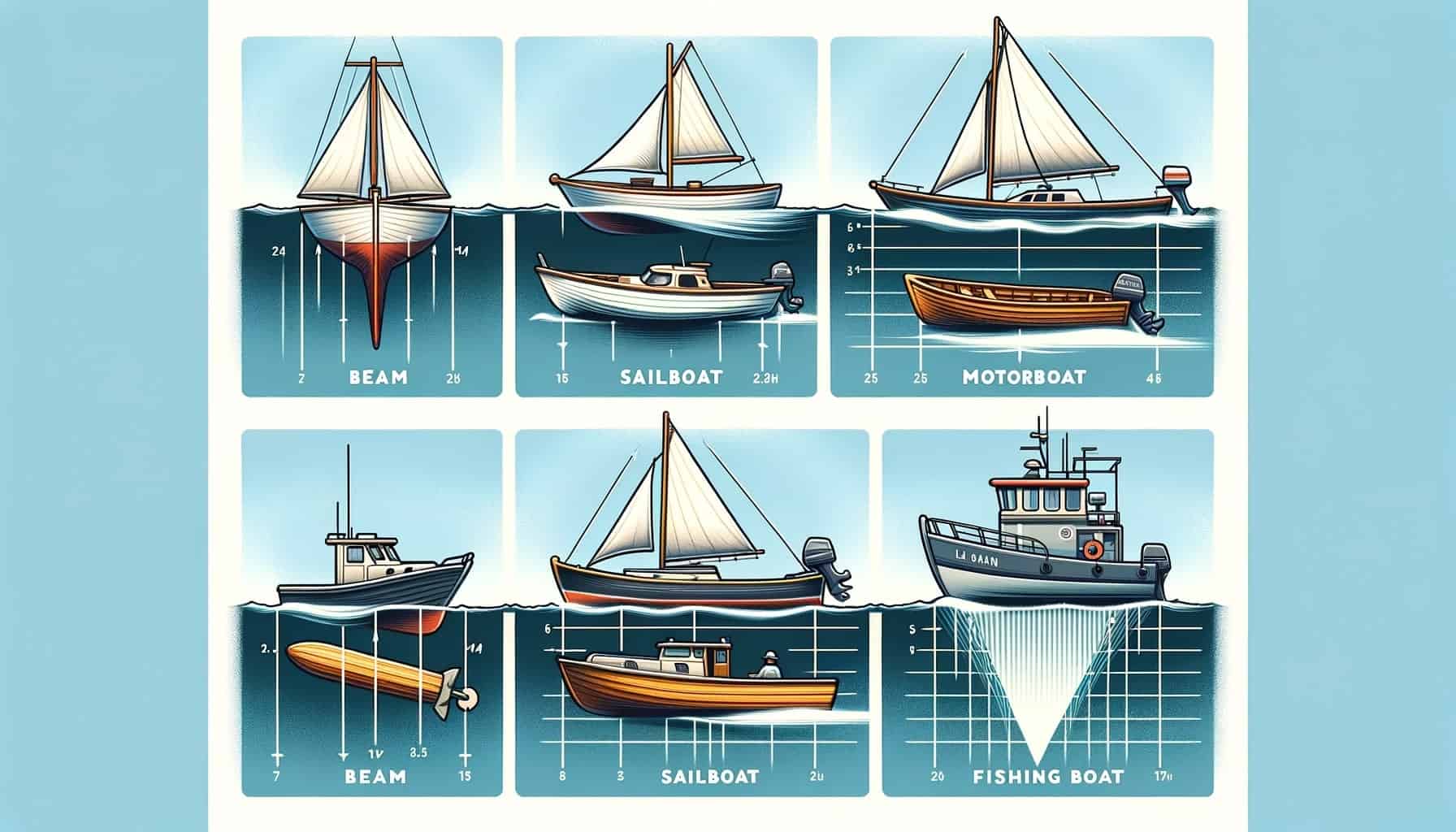The Sailor’s Guide: Understanding Boat Beam Dynamics
Picture this: you’re out on the water, enjoying a relaxing day on your boat. The sun is shining, the breeze is gentle, and all is right in the world. But have you ever stopped to wonder what exactly is meant by “beam” when it comes to boats?
You may have heard the term tossed around, but do you know what it means? Well, fret no more, because in this article, we’ll demystify the concept of beam on a boat and give you a clear understanding of its significance.
So whether you’re a seasoned sailor or just starting, get ready to become well-versed in the language of boating.
Definition of Boat Beam
Explanation of term
Boat beam refers to the width of a boat at its widest point, typically measured from one side of the hull to the opposite side. It is commonly used in boating terminology to describe the overall width and stability of a vessel.
The beam of a boat is an important measurement that impacts various aspects of boating, including stability, maneuverability, performance, space, and even the choice of boat design.
Significance in boating terminology
The beam of a boat is a crucial aspect of boating terminology as it directly affects the functionality and performance of a vessel. It provides valuable information about a boat’s stability, navigability, and overall seaworthiness.
The beam measurement is used by boaters, manufacturers, and regulators as a standard reference point when discussing and comparing different boat models. Understanding boat beams is essential for anyone involved in boating, from experienced sailors to novice enthusiasts.
Measurements of Boat Beam
How it’s measured
The boat beam is typically measured by taking a straight line from one side of the hull to the other, at the widest point of the boat. This measurement is usually expressed in feet or meters, depending on the region and preference.
It is important to note that the beam measurement should not include additional structures or attachments, such as rails, ladders, or outboard motors.
By measuring the beam accurately, boaters can gather vital information about a boat’s overall width and make informed decisions related to its performance and stability.
Units of measurement
The beam measurement can be expressed in various units of measurement, such as feet, meters, or inches, depending on the context and preference. While the most common unit used in the boating industry is feet, boaters need to be familiar with different units of measurement and their conversions.
Having a clear understanding of the units of measurement ensures effective communication and easier comparison between boat models, especially when considering boats from different regions or manufacturers.

How Boat Beam Influences Stability
Basic principles of stability
Stability is a fundamental concept in boating, ensuring the safety and comfort of those on board. It refers to a boat’s ability to stay upright and resist capsizing under varying conditions, such as waves, wind, and maneuvers.
Several factors contribute to a boat’s stability, and one of the key elements is the boat’s beam. Understanding the basic principles of stability, such as the center of buoyancy and the center of gravity, helps illustrate the direct relationship between boat beam and stability.
Role of beam instability
The beam of a boat plays a significant role in its stability. A wider beam generally enhances a boat’s stability, making it less prone to rolling and capsizing. This is because a wider beam provides a broader base of support, allowing the boat to distribute the forces exerted on it more evenly.
As a result, boats with wider beams are generally more stable and offer a smoother and more comfortable ride, especially in rough conditions. Conversely, boats with narrower beams may sacrifice some stability but often excel in other areas, such as speed and maneuverability.
Impact of Beam Width on Boat Performance
Effects on speed
The beam width of a boat can have a direct impact on its speed and overall performance. In general, boats with narrower beams tend to be faster due to their reduced water resistance. The narrower beam allows the boat to slice through the water more efficiently, reducing drag and enhancing its speed capabilities.
However, it is important to find a balance between speed and stability, as boats with excessively narrow beams may become too unstable at higher speeds, compromising safety and comfort.
Influence on maneuverability
Boat beam also influences the maneuverability of a vessel. Wider beams provide increased stability, but they can affect a boat’s agility and responsiveness. In tight spaces or when executing sharp turns, boats with wider beams may feel less responsive and require more effort to maneuver.
On the other hand, boats with narrower beams can generally navigate tighter spaces and make sharper turns with greater ease. Ultimately, the desired beam width depends on the boater’s preferences and the intended use of the boat.
Contribution to weight distribution
The distribution of weight across a boat is essential for maintaining stability and optimal performance. The beam width of a boat affects the distribution of weight, as a wider beam provides more space for weight distribution.
Boats with wider beams have increased capacity for carrying passengers, equipment, and supplies without compromising stability.
Conversely, boats with narrower beams may have limited weight-carrying capabilities and can become unstable if the weight is not properly distributed. Understanding the impact of beam width on weight distribution is crucial for maintaining stability and safety on board.

Relation Between Boat Beam and Hull Design
Different types of hull designs
boats come in a variety of hull designs, each serving different purposes and navigating various water conditions. Common hull designs include displacement hulls, planing hulls, and catamaran hulls.
Each hull design has unique characteristics that influence a boat’s performance, stability, and efficiency. The beam of a boat is closely related to its hull design, as different hull types require specific beam widths to optimize their functionality on the water.
How beam complement the hull design
The beam of a boat is closely intertwined with its hull design, and together, they work in harmony to achieve optimal performance and stability. For example, boats with displacement hulls, which are designed for efficient cruising and stability, generally have wider beams to maximize stability and weight-carrying capacity.
On the other hand, boats with planing hulls, which are designed for speed and maneuverability, often have narrower beams to reduce drag and enhance performance. The beam width complements the specific design characteristics of the hull, creating a balanced and efficient boating experience.
Impact of Boat Beam on Boat Space
Influence on interior space
The beam width of a boat directly impacts its interior space and comfort. Boats with wider beams generally offer more spacious interiors, providing ample room for passengers to move around and relax. The increased width allows for larger cabins, wider aisles, and more comfortable seating arrangements.
This is particularly important for boaters who prioritize comfort and require generous interior space for extended trips or liveaboard arrangements. On the other hand, boats with narrower beams may have more compact interiors and limited space for movement and relaxation.
Implications for storage and capacity
The boat beam also affects the storage capacity of a vessel. Wider beams provide more storage options, allowing boaters to stow their gear, equipment, and supplies with ease. The additional space created by a wider beam enables boaters to carry a greater amount of cargo, whether it be for day trips or extended voyages.
Conversely, boats with narrower beams may have limited storage capacity, which could restrict the amount of gear a boater can bring aboard. Considering the implications on storage and capacity is vital when selecting a boat that meets specific needs and requirements.

Variations in Boat Beams in Different Boat Types
Beam in yachts
Yachts are known for their luxurious and spacious characteristics, and the beam of a yacht significantly contributes to these qualities. Yachts generally have wider beams to maximize interior space, comfort, and stability.
The broader beam allows for larger cabin layouts, expansive living areas, and generous storage spaces, making yachts ideal for long cruises or accommodating large groups of people. The wider beam also enhances stability in open waters, ensuring a smoother ride and reducing the risk of rolling or capsizing.
Beam in canoes and kayaks
In contrast to yachts, canoes, and kayaks have narrower beams to optimize their maneuverability and performance in narrow waterways. The narrow beam of these small, paddle-powered vessels allows for easy navigation through tight spaces and agility in swift currents.
While the narrower beam may sacrifice some stability, it is a deliberate design choice to prioritize maneuverability. Canoes and kayaks are often used for recreational purposes, such as exploring calm rivers or paddling in scenic lakes, where maneuverability is key.
Beam in fishing boats
Fishing boats come in various sizes and designs, and the beam of a fishing boat depends on its intended use and the specific fishing requirements. Some fishing boats, such as bass boats, have narrower beams to navigate through small fishing spots and reach remote areas with ease.
These narrower beams also contribute to speed and maneuverability, allowing fishermen to reach their desired fishing locations quickly. However, larger offshore fishing boats may have wider beams for enhanced stability when fishing in more challenging and unpredictable waters.
Maximizing Beam Performance in Sailing
Ways to utilize beam for improved navigation
Sailboats rely on the wind to propel them through the water, and maximizing beam performance can enhance navigation and optimize sailing experiences.
One way to utilize a beam for improved navigation is by adjusting the sails based on wind conditions. A wider beam allows for greater sail area, capturing more wind and maximizing the sailboat’s speed.
Additionally, when sailing close to the wind, a wider beam reduces healing, the leaning of the boat caused by wind pressure, resulting in a more balanced and controlled sailing experience.
Impact of beam on sailing techniques
The beam of a sailboat affects various sailing techniques, from upwind sailing to downwind sailing. Sailboats with narrower beams excel in upwind sailing, allowing them to take advantage of the wind at acute angles and maintain their course efficiently.
On the other hand, sailboats with wider beams are better suited for downwind sailing, as the broader beam provides a stable platform for catching the wind from behind and maintaining control.
Understanding the impact of beams on different sailing techniques enables sailors to optimize their performance on different points of sail.

Legal Regulations and Standards for Boat Beams
International and local guidelines
Boat beam regulations and standards vary across different regions and countries, with international guidelines being established to ensure safety and uniformity.
These guidelines specify maximum beam widths for different boat categories, helping regulate the design and construction of boats.
Boaters must familiarize themselves with the applicable regulations in their area and adhere to the prescribed beam limits to ensure compliance and safety on the water.
Consequences for non-compliance
Failure to comply with boat beam regulations can have serious consequences, ranging from legal issues to compromised safety. Boaters who exceed the prescribed beam limits may face penalties, such as fines or restrictions on boat operation.
Furthermore, non-compliance with beam regulations can pose risks to the stability, maneuverability, and overall seaworthiness of a boat, potentially jeopardizing the safety of those on board.
To ensure a hassle-free boating experience, boaters need to be aware of and adhere to the applicable regulations and standards for boat beams.
Choosing a Boat: Considerations for Beam Width
Important factors to consider
When choosing a boat, several factors should be taken into consideration, and beam width plays a vital role in the decision-making process. One important consideration is the intended use of the boat. Those seeking stability, comfort, and spaciousness may opt for boats with wider beams, such as yachts or cruisers.
On the other hand, individuals prioritizing speed and maneuverability may prefer boats with narrower beams, such as speedboats or fishing boats.
Other factors, such as storage capacity, number of passengers, and water conditions, should also be considered when determining the appropriate beam width for a specific boating activity.
How beam width applies to different boating activities
Different boating activities require different beam widths to optimize performance and satisfy specific needs. For example, recreational boaters who enjoy leisurely cruises or overnight trips may benefit from boats with wider beams that offer ample interior space and stability.
On the contrary, individuals involved in water sports, such as water skiing or wakeboarding, may prefer narrower beams that enhance speed and agility. Fishing enthusiasts may consider beam widths that cater to the specific fishing conditions they encounter, be it inshore or offshore.
Each boating activity requires thoughtful consideration of beam width to ensure the best possible experience on the water.
In conclusion, a boat beam is a critical measurement in the world of boating. It directly influences a boat’s stability, maneuverability, speed, weight distribution, interior space, and overall performance.
By understanding and considering the impact of beam width, boaters can make informed decisions when selecting a boat that suits their needs and boating activities.
Whether it is a luxurious yacht, a nimble kayak, or a high-performance fishing boat, the beam width is a key factor to consider for an enjoyable and safe boating experience.








